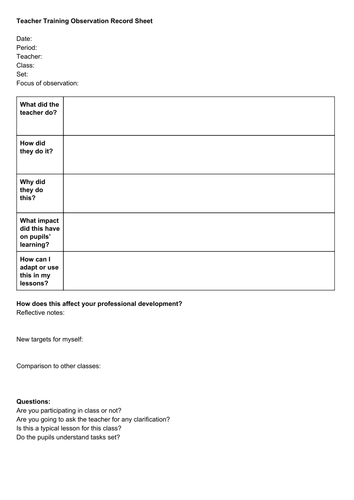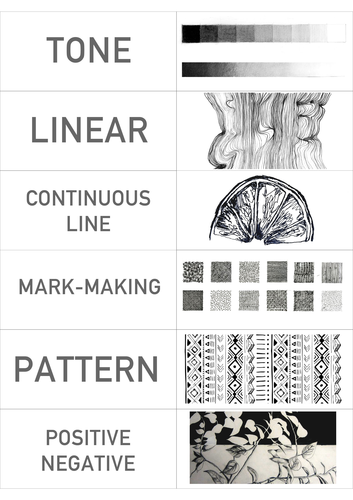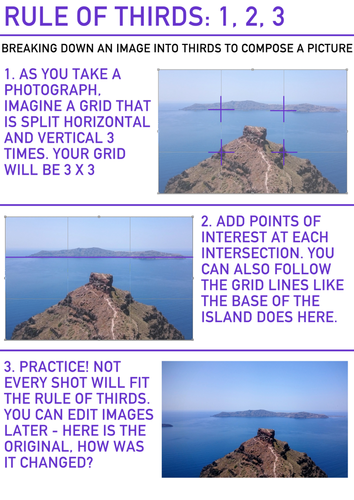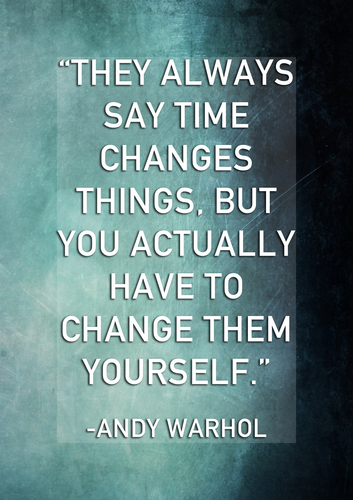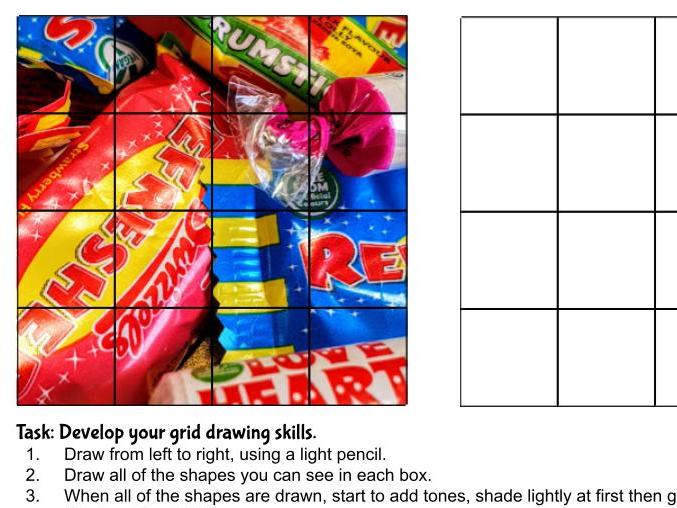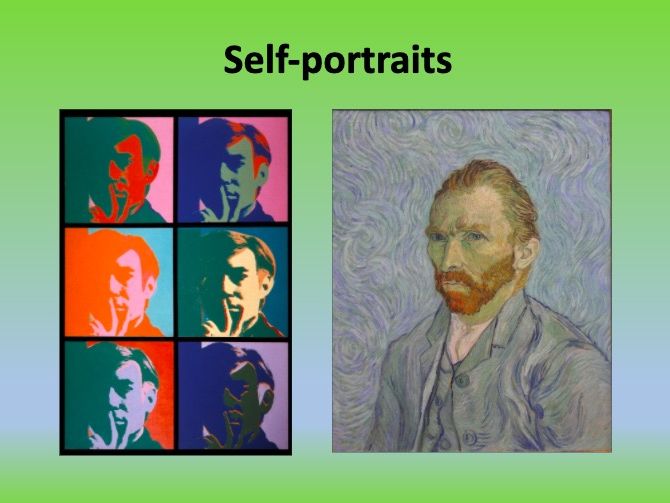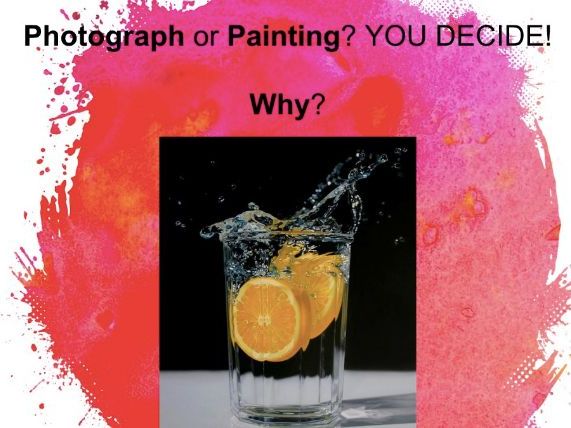
33Uploads
53k+Views
10k+Downloads
All resources

Mark-making step-by-step video (painting with PVA glue) for KS4
A step-by-step video for KS4 pupils exploring mark-making. I used this to allow pupils to self-pace their lesson.
The video was made specifically for a Landscape project, but you can use it with other topics exploring mark-making.
I used this for one lesson at KS4, most pupils did not finish their piece in one lesson. Excellent for differentiation as pupils can stop, rewind and rewatch parts of the video if they need to.

Teacher Training Observation Record Sheet
A record sheet I've put together for trainee teachers who are observing classes. I've used this for secondary school observations.
Includes questions you should ask yourself when observing in classes, from date and time to professional development.
Includes questions about the lesson in hand and self reflection.
Easy to use with clear headers for different questions and data needed in your evidence.

Art keywords activity for paired work (starter or plenary)
Use the resource to test your pupils knowledge on keywords and techniques.
One half of the pair has the keyword, the other has the example. Mix up the pairs and let pupils choose one, then they have a limited amount of time to find their partner. Pupils must work co-operatively to discuss which technique matches the correct keyword.
Good for getting pupils into small groups or pairs and also tests their knowledge of techniques. I have used as a quick plenary or starter.
Keywords included are:
Tone, Linear, Continuous Line, Mark-Making, Pattern, Positive & Negative

Rule of Thirds guide poster for photography
A wall display in size A3 and A4 for the Rule of Thirds in photography. Explains the rule of thirds in 3 simple steps, with an example. Also includes a question about how the rule of thirds was achieved in the example.
Great for the photography classroom, easy to refer to and in a clear, simple format. Print out the poster and use in your classroom, give pupils time to read and understand the steps, then try themselves. Encourages pupils to use the rule of thirds when editing their work too.

LGBTQIA+ List of artists - help sheet to be shared online or printed
A comprehensive list of LGBTQIA+ artists from around the world, from painters, to photographers, sculptors and animators who identify as LGBTQIA+
This pdf shows over 60 artists identifying as LGBTQIA+. The aim is to celebrate their work, their lives and share their artwork with our students.
The pdf has a picture of the artist’s work, their name and a direct link to the artist’s website: ideal for sharing with your students online or printing out for lessons. There is a QR code that students can scan if the document is printed out for them.
The pdf has 6 pages with the artists listed clearly and in alphabetical order.

GCSE Photography Grade 9 Exam Example Project
This is a GCSE Photography project which achieved a Grade 9 on the AQA exam board. The project is from the Externally Set Exam (ESA) for the ‘Fragments’ question.
It was completed on PowerPoint / Google Slides (not printed into sketchbooks) and edits were done on Photoshop - if you don’t have photoshop they can be done online at photopea.com There are some ‘physical edits’ which were printed in school.
The photographs were taken on the student’s phone.
The project shows how to meet all of the Assessment Objectives successfully and fully - from research, to experiments, refining ideas and presenting final pieces. You could use it as a template to show other students if you wish.

Mark Making and Texture KS3 and KS4
A lesson on mark making and texture for use in KS3 and KS4. Has a clear task/learning objective. Can easily be differentiated and links to relevant artist. Includes powerpoint presentation with a starter, main (with challenge question) and plenary. Can be adjusted depending on what materials/resources you have in school - this one uses Indian ink.

Inspirational Artist Quotes (Art classroom motivational display posters)
10 wonderful, inspirational quotes from world famous artists.
All with a unique art-textured background, ideal for decorating your classroom. Good for encouraging hard work and effort rather than talent:
“I am seeking. I am striving. I am in it with all my heart.” Vincent van Gogh
“Creativity takes courage.” Henri Matisse
“They always say time changes things, but you actually have to change them yourself.” Andy Warhol
“Art washes away from the soul the dust of everyday life.” Pablo Picasso
“Great art picks up where nature ends.” Marc Chagall
“The job of the artist is always to deepen the mystery.” Francis Bacon
“To create one’s own world takes courage.” Georgia O’Keeffe
“Art is not what you see, but what you make others see.” Edgar Degas
“Have no fear of perfection, you’ll never reach it.” Salvador Dali
“If people knew how hard I worked to get my mastery, it wouldn’t seem so wonderful at all.” Michelangelo
Simply print out and stick up, these are designed at A4 size but you could size them up to A3.

Fun Art Assessment Ideas
A long list of different, fun and engaging assessement activities specifically design for art lessons. There are a range of formative and summative assessment ideas, as well as self-assessment tasks, peer-assessment activities and whole-class assessment ideas. All of the resources needed are included in the presentation. A fun way to jazz up the bog standard WWW / EBI.

Art Lesson - Drawing the Human Figure
This is a stand-alone art lesson that helps to teach students how to draw the correct proportions of the human figure. This is an introduction to figure drawing, which can be used in a bigger scheme of work looking at the human figure, or it can be used as a cover lesson.
This lesson can be used with KS3 or KS4 students and can be easily differentiated. It includes 3 main activities (starter - main - plenary) and can be taught by a non-specialist. It has clear learning objectives and an extension.
It encourages students to look carefully at the proportions of the human body.
I have made this lesson as I was unable to find a quick one-off lesson that was not just focused on drawing. This lesson has different activities to keep students engaged.
Any teacher would be able to deliver the lesson, you just need to make a photocopy of one of the resources attached to the PowerPoint.

Continuous Line Drawing
Continuous Line Drawing lesson for a 1 hour Art Class (mine had 25 - 30 students).
I have updated this lesson to include more drawing activities and student evaluations
Times can be changed for class sizes. I repeated the timed drawings with different materials (ie. pen, pencil, felt tip, ink) and objects used to extend times. I also extended the discussion times if it was a smaller class.
The presentation introduces a continuous line drawing artist, has a discussion about their work, introduces keywords and has three drawing activities (continuous line, blind and in pairs - moving paper instead of the pen to draw!)
Includes artist examples, teacher examples, different materials / techniques and a plenary. Encourages art-specific language to describe work.
You will need some natural forms for students to draw. I chose dried fruit, shells, leaves etc.
There is more information about this lesson here.

Grade 9 GCSE Art Example Projects
There are six Grade 9 full art project examples on the presentation, including sheets of student’s secondary and primary research and artist research.
I have included all of the student’s observational / working drawings, development work, experimentation, plans and final pieces. I have added close up images of the Grade 9 observational drawing work so you can use the presentation to show your own students if you wish.
I have chosen very different exam projects so you can see a full range of techniques and approaches to the different exam questions. The projects are a mix of coursework and the externally set exam by AQA.
I have added titles to each of the slides in ‘student speak’ so your students can clearly see examples of what each stage of a Grade 9 art project looks like. All of the annotations should be legible too.
I have included photographs of all of the final pieces completed in the 10 hour exam / controlled assessment. As well as the final pieces, I have included close up images so you can clearly see the details and quality of the work. In total, there are 97 slides with examples of Grade 9 GCSE art projects.

Grid Drawing Worksheets. 70+ slides for cover or extension tasks
This Grid Drawing presentation has over 35 different pictures for students to choose to draw from. Each picture has an ‘easy’ and ‘hard’ version so there are over 70 slides in total for you / students to choose from. Each slide can be printed to give out as a Grid Drawing worksheet, ideal for cover / sub lessons or extension tasks.
The images are all high res so each slide can easily be printed to A4, then blown up on the copier (if needed). There is a huge range of themes:
Sweets, Cake, Fruit & Vegetables, Flowers, Architecture, Tools, Cutlery, Facial Features like eyes, mouth and ears, Fists, Animal textures, reptiles, fish etc. Lego and toys.
I have tried to make the task as accessible to all students as possible, so some images are more complex and some are more simple. On the ‘easy’ version of each picture, there is a very light copy of the image for students to draw directly over if they are struggling with the blank grid.
The task instructions are written at the bottom of the sheet and there is room for students to write their name on the sheet.

KS3 Art Easy 3D Project
I have found this 3D art project great for engaging boys in art as they get to use new tools and materials and it is really tactile! I marked on teamwork skills rather than ability and the project can be extended or shortened.
This is a full scheme of work asking students to build structures (from cardboard) based on architecture designed by Michael Wilford. Students work in groups to design then construct creative ‘buildings’ - from cardboard using minimal materials. They will need carboard, tape, glue guns (if you have them), craft knives.
I designed the brief around ‘vessels’ rather than buildings so students didn’t just build houses or blocks.
I taught this over a six week term but it can be shortened or extended easily. The project includes all of the entry tasks / starters, main activities and plenaries that I used.

GCSE Art 'Objects' project - full scheme of work
This is a full GCSE art presentation for a coursework project with the theme ‘objects’ or ‘still life’.
Objects was a previous starting point on the AQA ESA so I used it as a coursework project too.
The presentation covers:
research, experimentation, refining work and developing final ideas
all of the AQA assessment objectives for GCSE art
different types of research including artist, primary and secondary
a range of experiments including grid drawing, drawing with charcoal, painting with acrylic, drawing with felt tips, lino reduction printing, and photography techniques
different artists and how they respond to the theme ‘objects’
how to develop ideas by combining materials / planning final outcomes
There are 95 slides in total.
There are entry tasks / exit tasks / homework tasks and lesson tasks for each of the techniques.
There are also student examples throughout the presentation and notes on some slides to explain what I was doing with my classes.

KS3 Easy Clay Vessels Project & Colour Theory
This is a simple but effective clay project that I teach with Year 9, but could be any KS3 / KS4 project. The outcomes are excellent and I have found it even keeps Y9 boys engaged…
This is a full scheme of learning which introduces various techniques for clay work, including incising and applying, contructing, building etc. The project looks at different artists and their work, then asks students to design their own vessel based on underwater textures. The are opportunities for cross-curricular learning etc.
The clay vessels are simple to build, and there are clear steps and instructions showing students how to. Before students build their final piece, there are lessons teaching them to use various clay tools on a simple slab in order to master incising into the clay and applying clay onto clay. Therefore students end up with two pieces of work, one ‘practise’ piece and one ‘final’ piece. This allows time for one to be fired / painted while the other is drying.
The end of the project introduces some basic colour theory, looking at harmonious colours, accent colours, tints and shades. We painted our vessels using acrylic but you could easily change how you paint / decorate yours.
The scheme of learning includes all of the slides I used over a series of 6 - 7 weeks. Entry tasks, starters, mini acitivities, peer assessment, self assessments, plenaries etc. are all included. The materials I used are just clay and blue carving tools. Students mixed their own slip after I showed them how to.

Drawing portraits: KS3 art scheme of work
A full scheme of work covering all of the basics in drawing realistic portraits. Aimed at KS3 art students, I usually teach this with Year 7.
The powerpoint includes nearly 50 slides, including a quick history of portraiture. It breaks down drawing all of the facial features into easy to follow steps. Each lesson has an entry task/starter activity, challenge and homeworks are included. There are examples of students’ work, as well as links to easy to follow videos.
The scheme of work can be easily adapted and I have tried to make it really simple to follow.

Abstract Still Life Painting Scheme of Work KS3
A KS3 painting project based on Abstract Still Life. This full project covers a series of lessons, teaching students about observational drawing, colour theory, pattern and mark-making and painting techniques.
It includes artist research, experimentation, developing ideas and final outcomes.
I have taught it with Y8 KS3 students, however it can be easily adapted for any year group. The project includes entry tasks / starters and plenaries / clear lesson outcomes and examples of students work at each stage.

GCSE Art Scheme of Work - The Blue Planet
This is a full GCSE scheme of work for a project based on The Blue Planet.
It covers all four assessment objectives and explains to students how they can achieve different grades. It guides them through their presentation and gives examples of different levels of work.
The project includes slides for entry tasks / starters / plenaries etc and has a full range of artists’ work to show. The lessons are planned out as I used them, however you can easily remove or change etc. any slides you want to.
There are 87 slides in total.
This project could easily be adapted for Natural Forms, Pollution or similar themes. It explores:
AO1 - research. It shows examples of excellent research design sheets and sketchbooks
AO2 - experimentation. It includes a wide range of experiments and ideas for students.
AO3 - annotations and design ideas. There are a range of examples of how to annotate work and various ideas for final pieces.
AO4 - final designs. It clearly explains to students what they need to do to reach different grades and marks for their final pieces.
You can read more about this GCSE Art full scheme of work here.

Effective Starters & Plenaries for Art and Design
I have created a huge PowerPoint presentation with over 45 starter or plenary activities for your art classes.
The activities are all art-related and can be used in KS3 or KS4 art lessons, either as entry tasks, starters, plenaries or exit questions. Sometimes I put the question on the board at the start of the lesson then come back to it at the end.
The slides are made up of questions, challenges, thought prompts, image analysis, riddles, true or false competitions, thunks and more. Some are very general so can be used across any class or topic, and some are more specific and related to different art movements - for example, Pop Art or Graffiti.
You can use the slides to generate discussion or have students discuss things in groups/pairs etc. I have made them to be as adaptable to your lessons/teaching as possible.


